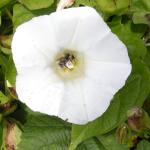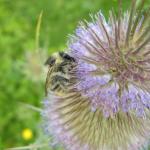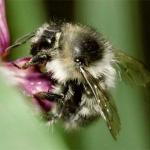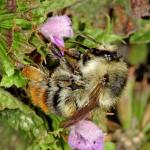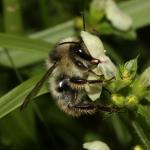Bombus dagestanicus RADOSZKOWSKI 1877; Bombus distinctus VOGT 1909; Bombus narbonensis KRUSEMAN 1958; Bombus lederi VOGT; ESMAILI & RASTEGAR [1974]
For details see Williams Bumblebees of the World
A rather local lowland species of bumble bee which has shown a significant decline in range in recent years. Identification keys and general biology are found in Sladen (1912), Free & Butler (1959), Alford (1975) and Prŷs-Jones & Corbet (1991). A very rare melanic form, f. nigrescens, was found a few times in East Sussex in the 1920s. Darker specimens were found again in 2011 on Dungeness (N Gammans pers. comm) and at Deal (RL Evans & ED Moss, pers. comm)
Formerly locally frequent in England, south and east of the Severn-Wash line with scattered records from lowland areas over the rest of England, coastal areas of Wales and scattered localities in lowland Ireland. Since the 1960s this species has shown a severe reduction in range. In 1999 there were only seven areas with known populations of this bumblebee: four in England and three in South Wales. There are a few modern records for the Burren, Ireland. The species ranges through most of Europe except the northern parts of Scandinavia and the Mediterranean area eastwards to the Urals.
Listed as a Notable B species by Falk (1991) (now known as Scarce (Nb)), but has become much rarer in recent years and may now be in danger of becoming extinct in Britain.
Occurs in a variety of open, flower-rich situations such as sand dunes, edges of salt-marshes, shingle beaches, chalk downland and heathland.
Late May until September.
Nests are usually built in a slight hollow on the ground amongst rough vegetation, or just underground, in early June. The workers, of which there are usually less than one hundred per nest (F. Smith, 1868; Sladen, 1912; Hasselrot,1962; Alford, 1975), emerge from mid-June onwards and the new generation of males and females appears during late August and September.
The comb is light yellow with a neat appearance; little wax is secreted, this being worked into thin sheets (Sladen, 1912; Alford, 1975). Occupied nests are illustrated by E. von Hagens (1986) and Geiser (1988). Grandi (1961) has described and figured the prepupa.
A wide variety of flowers are visited, mainly from the families Fabaceae, Boraginaceae, Lamiaceae, Scrophulariaceae, Dipsacaceae and Asteraceae.
Profile written: 2001
Updated: December 2011


